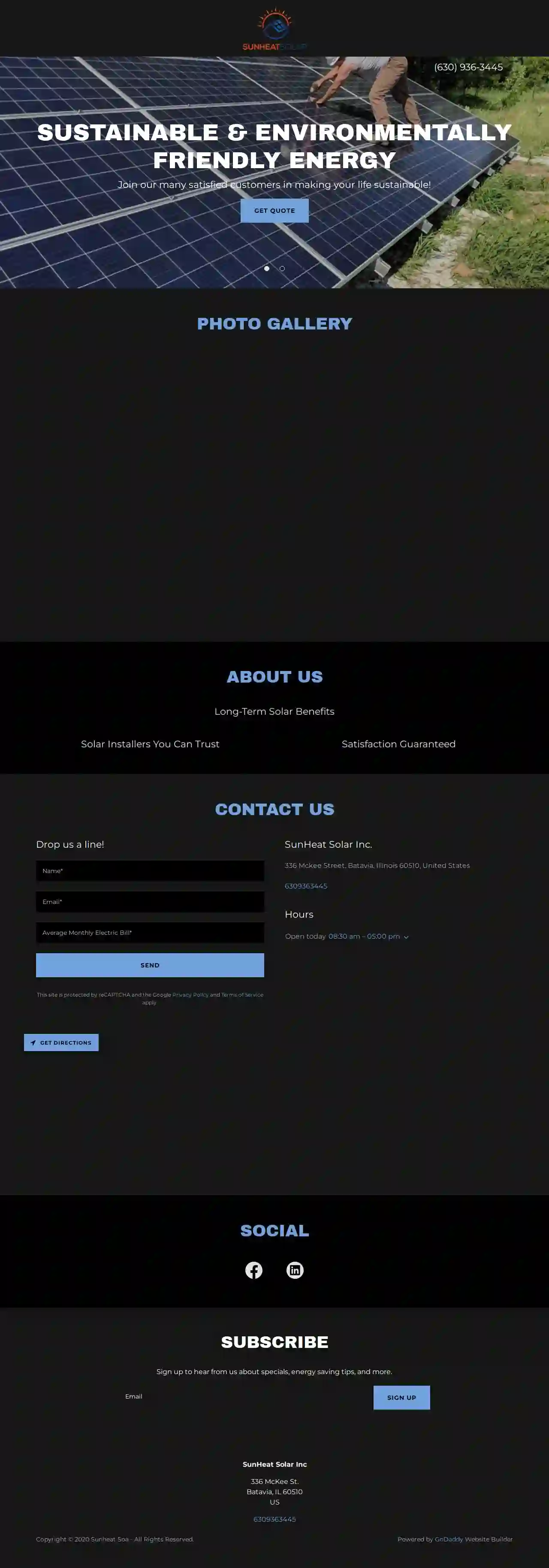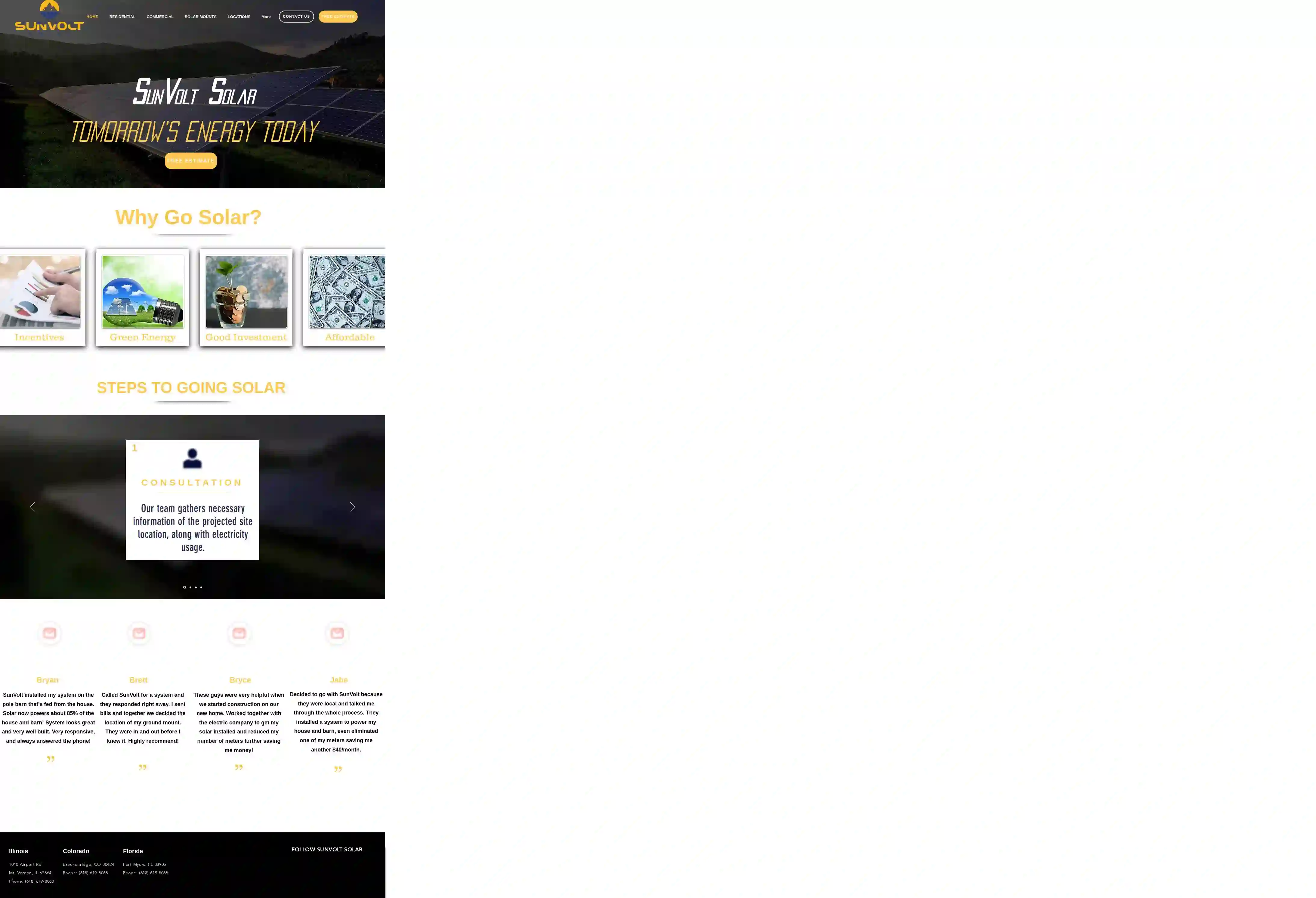Solar Installers Olympia Fields
Find the best Solar Energy Company in Olympia Fields
Get 3 FREE Solar Panel Installers quotes for your project today! Compare profiles, reviews, accreditations, portfolio, etc... and choose the best offer.

Solar Contractors Chicago
275 Payson St, Hoffman Estates, 60169, USSolarCC is your go-to resource for the best solar panel and electric vehicle (EV) charging businesses in Chicago and the surrounding Illinois cities. Learn vital information about solar panel installations, such as tax breaks, special features, discounts, and prevailing trends. Discover our blog, offering insightful information, data, and learning tools about solar energy and electric vehicle charging.
- Services
- Why Us?
- Accreditations
- Our Team
- Testimonials
- Gallery
Get Quote
Advanced Power USA
514 reviews123 Main St, Suite 100, Aurora, 60001, USAdvanced Power USA is a company that specializes in providing clean, renewable energy to homeowners through solar power. They offer a range of services including installation, maintenance, and consultation to help homeowners make the switch to solar energy. Their team consists of experienced professionals who are dedicated to providing high-quality service and ensuring customer satisfaction.
- Services
- Why Us?
- Accreditations
- Our Team
- Testimonials
- Gallery
Get Quote
SunHeat Solar, Inc.
4.713 reviewsSunHeat Solar Inc., Batavia, Illinois, 336 Mckee Street, 60510, USSunHeat Solar Inc. is a sustainable and environmentally friendly energy provider. They offer long-term solar benefits and are trusted solar installers with a satisfaction guarantee. Their mission is to help customers make their lives sustainable.
- Services
- Why Us?
- Accreditations
- Our Team
- Testimonials
- Gallery
Get Quote
FreeWorld Solar
538 reviewsSuite 100, Chicago, IL, 123 Solar Street, 60601, USFreeWorld Solar is a leading provider of solar energy solutions in Chicago and surrounding areas. Our team of experts is dedicated to helping property owners save money on electricity by harnessing the power of the sun. We offer a range of services including solar panel installation, battery storage, EV chargers, commercial development, and solar financing and leasing. Our goal is to make solar energy accessible to all, which is why we provide free estimates and flexible financing options while helping you find applicable tax incentives and rebates.
- Services
- Why Us?
- Accreditations
- Our Team
- Testimonials
- Gallery
Get Quote
SunVolt Solar
51 reviews1040 Airport Rd, Mt. Vernon, 62864, USSunVolt Solar is a local business that specializes in providing solar energy solutions for residential and commercial properties. They offer a range of services including solar mounts, location assessments, and consultations to help clients transition to green energy. SunVolt Solar emphasizes the benefits of solar energy such as incentives, green energy, good investment, and affordability. They have a team of experts who work closely with clients to understand their electricity usage and provide tailored solutions. SunVolt Solar has offices in Illinois, Colorado, and Florida.
- Services
- Why Us?
- Accreditations
- Our Team
- Testimonials
- Gallery
Get Quote
WindSoleil Solar and Wind Energy Services
4.642 reviews401 N. Trumbull Ave Ste D, N/A, Chicago, 60624, USWindSoleil provides Solar and Wind Energy Installation Services in Illinois for home and businesses, Solar Panels, Wind Turbines, Off-Grid Kits, Portable Solar Chargers, etc, Worldwide.
- Services
- Why Us?
- Accreditations
- Our Team
- Testimonials
- Gallery
Get Quote
Innogy Renewables US LLC
54 reviewsBeverly Hills, CA, 123 Solar Way, 90210, USHorizon Co Solar Company is a leading provider of solar energy solutions, dedicated to helping homeowners and businesses harness the power of the sun to save on energy costs and reduce their carbon footprint. With a team of experienced professionals and a commitment to quality, Horizon Co Solar Company offers a range of services including solar panel installation, maintenance, and repair. Our mission is to make solar energy accessible and affordable for everyone, while promoting a sustainable future for our planet.
- Services
- Why Us?
- Accreditations
- Our Team
- Testimonials
Get Quote
93Energy Solar
4.928 reviewsSkokie, IL, 4517 Oakton Street, 60076, US93Energy is a leading provider of solar energy solutions for commercial and residential properties in the Northern Midwest. Our mission is to empower businesses and individuals to take control of their monthly electrical costs by harnessing the power of the sun. We offer a range of services including solar panel installation, EV charging solutions, and energy storage options. Our team of experts assesses each client's unique situation to provide tailored solutions that maximize savings and environmental sustainability.
- Services
- Why Us?
- Accreditations
- Our Team
- Testimonials
- Gallery
Get Quote
WindSolarUSA, Inc.
4.713 reviews104 North 6th Street, Suite 300, Springfield, 62701, USWindSolarUSA, Inc. is a leading provider of renewable energy solutions in Illinois. They offer a range of services including solar, wind, and LED solutions. Their mission is to provide affordable and sustainable energy solutions to individuals, businesses, and municipalities. They have a team of experienced professionals who can help you assess your energy needs and provide customized solutions.
- Services
- Why Us?
- Accreditations
- Our Team
- Testimonials
- Gallery
Get Quote
The Solar Soldier
520 reviews444 West Lake Street, Suite 1700, Chicago, 60606, USThe Solar Soldier is a veteran-owned business dedicated to providing comprehensive solar solutions tailored to meet your energy needs. Our mission is to lead in the adoption of clean energy by providing consulting services and solar designing tailored to each client's unique needs. We offer a wide range of services including solar + roof installations, EV Charger, service panel upgrades, and more.
- Services
- Why Us?
- Accreditations
- Our Team
- Testimonials
- Gallery
Get Quote
Over 4,210+ Solar Installers onboarded
Our solar contractors operate in Olympia Fields and surrounding areas!
SolarCompaniesHub has curated and vetted the Best Solar Companies arround Olympia Fields. Find a reliable business today.
Frequently Asked Questions About Solar Installers
- System size (measured in kilowatts, or kW)
- Type of solar panels (monocrystalline, polycrystalline, thin-film)
- Roof complexity (pitch, size, obstructions)
- Labor costs in your area
- Available incentives and rebates
- Solar Panel Warranty: From the panel manufacturer, typically covering defects in materials and workmanship for 10-25 years. Some manufacturers offer performance guarantees, ensuring a certain level of energy output over time.
- Solar Installation Warranty: From the solar installer, covering the quality of the installation work for 1-10 years. This warranty protects you from leaks, faulty wiring, or other issues caused by improper installation.
- String Inverters: Connect multiple panels in a series (a 'string'). A cost-effective option for simple systems, but a single panel issue can affect the entire string.
- Microinverters: Attach to each individual solar panel, maximizing energy production even if some panels are shaded. They are more expensive but offer greater efficiency and monitoring capabilities.
- Power Optimizers: Similar to microinverters, but less expensive. They optimize the output of each panel and provide individual panel monitoring, but a central inverter is still required.
- Hybrid Inverters: Combine a solar inverter with a battery charge controller, allowing for seamless integration of battery storage.
- Adequate Sunlight: Unobstructed sunlight for a significant portion of the day.
- Sufficient Space: Enough space to accommodate the desired number of panels.
- Structural Integrity: A strong roof structure capable of supporting the weight of the panels.
- Appropriate Orientation and Tilt: Ideally, the roof should face south (in the Northern Hemisphere) or north (in the Southern Hemisphere) with a tilt angle close to the latitude of your location. However, other orientations and tilts can still be effective.
What is the average cost of solar panel installation in USA?
What kind of warranty should I expect for my solar panel system?
What are the different types of solar inverters?
How do I know if my roof is suitable for solar panels?
What is the average cost of solar panel installation in USA?
- System size (measured in kilowatts, or kW)
- Type of solar panels (monocrystalline, polycrystalline, thin-film)
- Roof complexity (pitch, size, obstructions)
- Labor costs in your area
- Available incentives and rebates
What kind of warranty should I expect for my solar panel system?
- Solar Panel Warranty: From the panel manufacturer, typically covering defects in materials and workmanship for 10-25 years. Some manufacturers offer performance guarantees, ensuring a certain level of energy output over time.
- Solar Installation Warranty: From the solar installer, covering the quality of the installation work for 1-10 years. This warranty protects you from leaks, faulty wiring, or other issues caused by improper installation.
What are the different types of solar inverters?
- String Inverters: Connect multiple panels in a series (a 'string'). A cost-effective option for simple systems, but a single panel issue can affect the entire string.
- Microinverters: Attach to each individual solar panel, maximizing energy production even if some panels are shaded. They are more expensive but offer greater efficiency and monitoring capabilities.
- Power Optimizers: Similar to microinverters, but less expensive. They optimize the output of each panel and provide individual panel monitoring, but a central inverter is still required.
- Hybrid Inverters: Combine a solar inverter with a battery charge controller, allowing for seamless integration of battery storage.
How do I know if my roof is suitable for solar panels?
- Adequate Sunlight: Unobstructed sunlight for a significant portion of the day.
- Sufficient Space: Enough space to accommodate the desired number of panels.
- Structural Integrity: A strong roof structure capable of supporting the weight of the panels.
- Appropriate Orientation and Tilt: Ideally, the roof should face south (in the Northern Hemisphere) or north (in the Southern Hemisphere) with a tilt angle close to the latitude of your location. However, other orientations and tilts can still be effective.